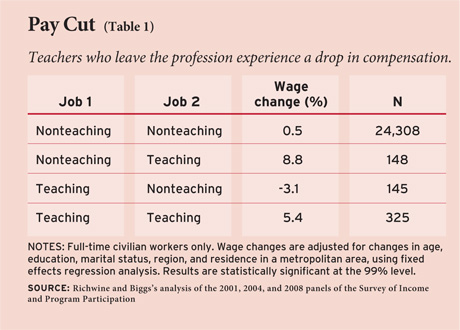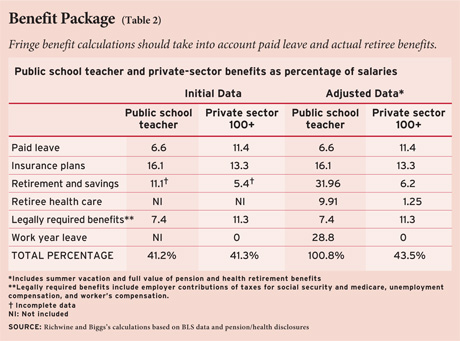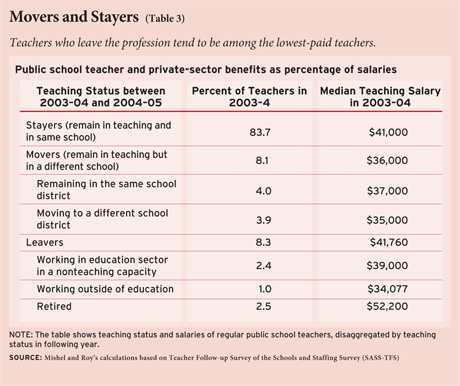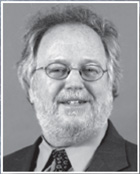Over the past few years, as cash-strapped states and school districts have faced tough budget decisions, spending on teacher compensation has come under the microscope. The underlying question is whether, when you take everything into account, today’s teachers are fairly paid, underpaid, or overpaid. In this forum, two pairs of respected economists offer very different answers. Andrew Biggs of American Enterprise Institute and Jason Richwine of the Heritage Foundation argue that, considering skills, workload, and benefits, today’s teachers are, on average, overpaid. Lawrence Mishel of the Economic Policy Institute and Joydeep Roy of Columbia University and New York City’s Independent Budget Office argue that Richwine and Biggs are off the mark, and that teachers deserve a raise. Read on, and decide for yourself.
Jason Richwine & Andrew Biggs: Public school teachers are “desperately underpaid,” Secretary of Education Arne Duncan said recently. A documentary film called American Teacher, which premiered last fall, portrayed heroic teachers struggling to get by on paltry incomes. The book on which the film is based went so far as to claim that “a teaching career guarantees a life of subsistence earning—month to month and hand to mouth.”
Is public-school teacher compensation really inadequate? Like all public workers, teachers should be paid at a level commensurate with the market value of their skills, which represents the compensation needed to attract and retain a given set of workers. But comprehensive assessments of teacher compensation—covering salaries, fringe benefits, and job security—are uncommon.
As we will show, the analyses that do exist tend to be misleading and incomplete. While much variation in teacher pay exists across the nation and within the profession—younger teachers are paid considerably less than older ones, for example—the average public school teacher is compensated considerably better than comparably skilled private-sector workers.
Salaries

We begin with an oft-cited data point: after controlling for differences in education, experience, race, gender, marital status, and other earnings-related characteristics, public school teachers receive considerably lower total annual salaries than private workers. In fact, when treated as full-year employees, i.e., excluding the value of teachers’ longer summer vacation, by our own estimate public school teachers receive a 19 percent salary penalty.
Yet this type of analysis, which uses linear regression to adjust for skill differences, cannot support strong conclusions about the salaries of a single occupation. Unobserved ability differences, systematic errors in the observed variables, and varying work conditions could all be influencing the observed salary gap.
Imagine analyzing other occupations. If we added to the regression an indicator for architects, for example, we would find that architects receive a salary premium over seemingly comparable workers. Yet few people would immediately conclude that architects are “overpaid,” since architects could easily have skill characteristics not captured by the existing variables. Those who use the standard regression to argue that teachers are underpaid must also conclude that architects are overpaid, food-service workers are underpaid, computer programmers are overpaid, and so on.
The first argument for why the standard regression is misleading concerns the use of years of education (or highest degree obtained) as a measure of teacher skill. The implicit assumption is that education’s effect on future earnings is consistent across fields of study. Does a person who majored in education possess the same skills as the average college graduate, much less one who majored in engineering? Probably not. Students majoring in education score lower than other college students on tests like the SAT and GRE.
Research by Richard Arum, Josipa Roksa, and Esther Cho, based on the Collegiate Learning Assessment, which administers tests of critical-thinking and writing skills upon entrance to college and in follow-up years, concludes that education majors acquire considerably fewer general skills during college than students majoring in the social sciences, humanities, math, or science. If education programs enroll less-talented students and impart less knowledge along the way, one would expect education majors to earn less after graduation than majors in other fields, whether they worked as teachers or in other jobs.
For a more objective measure of skills, we turn to the National Longitudinal Survey of Youth (NLSY). Participants in the NLSY took the Armed Forces Qualification Test (AFQT), which measures word knowledge, paragraph comprehension, arithmetic reasoning, and mathematics knowledge. These skills are important in any job, and particularly in teaching, where the goal is to convey them to students. When controlling for AFQT scores rather than years of education, no wage gap between teachers and nonteachers is evident. In other words, teachers receive salaries around where we would expect based on the results of standardized tests.
Of course, teaching involves many skills that are not captured by standardized tests, including organizational and interpersonal skills. Are teachers adequately rewarded for these noncognitive abilities?
Using data from the Census Bureau’s Survey of Income and Program Participation, we are able to track changes in individuals’ salaries as they switch jobs. If teachers are not paid fairly for their noncognitive skills, we would expect teachers who shift to private-sector jobs to receive significant raises.
 As Table 1 indicates, the control group that shifts from nonteaching jobs to other nonteaching jobs experiences an average real salary increase of 0.5 percent. Workers who switch from nonteaching to teaching receive an increase of 8.8 percent. Teachers who change to nonteaching jobs, in contrast, see their wages decrease by 3.1 percent. In other words, the effect on salaries of switching into or out of a teaching job is precisely the opposite of what one would expect if teachers were underpaid. State-level studies have found similar patterns. Unobserved skill differences between teachers and nonteachers, not a general salary bias against the teaching profession, make teacher salaries seem low.
As Table 1 indicates, the control group that shifts from nonteaching jobs to other nonteaching jobs experiences an average real salary increase of 0.5 percent. Workers who switch from nonteaching to teaching receive an increase of 8.8 percent. Teachers who change to nonteaching jobs, in contrast, see their wages decrease by 3.1 percent. In other words, the effect on salaries of switching into or out of a teaching job is precisely the opposite of what one would expect if teachers were underpaid. State-level studies have found similar patterns. Unobserved skill differences between teachers and nonteachers, not a general salary bias against the teaching profession, make teacher salaries seem low.
What about work conditions? Do the daily demands of working in a classroom justify a salary premium? One of the more common claims about work conditions is that teachers work longer hours than nonteachers. But according to the best available data, teachers work around 40 hours per week, including work outside of the classroom, about the same as nonteachers.
A better way to assess whether teaching requires a compensating differential for work difficulty is by comparing public-school teacher salaries to private-school teacher salaries. When the standard regression is limited to teachers, those who work for public schools receive a 10 percent salary premium. University of Missouri economist Michael Podgursky has found that the premium is larger when the comparison includes only low-poverty suburban schools, a sector in which public and private schools are presumably most similar. This is inconsistent with the theory that the public-school salary premium reflects a compensating differential for working with more-difficult students.
In summary, based on 1) no evidence of a salary penalty when controlling for AFQT rather than years of education, 2) job switchers receiving higher salaries as teachers than as nonteachers, and 3) public school teachers receiving higher salaries than private school teachers, we conclude that the standard regression is, at best, highly misleading.
Fringe Benefits
We turn now to fringe benefits, where our starting point is the Employer Costs for Employee Compensation (ECEC) data set published by the Bureau of Labor Statistics (BLS). The ECEC data set indicates that public school teachers receive total fringe benefits equal to around 41.2 percent of their salaries. Our nonteaching control group—workers in establishments of 100 or more people, which tend to pay generous benefits—receive benefits equal to 41.3 percent of their salaries.
 The initial data are shown in the first two columns of Table 2. Previous studies of teacher benefits have essentially stopped here, concluding that there is not much difference in benefits between teachers and nonteachers. As noted by the question marks, however, the ECEC data are incomplete.
The initial data are shown in the first two columns of Table 2. Previous studies of teacher benefits have essentially stopped here, concluding that there is not much difference in benefits between teachers and nonteachers. As noted by the question marks, however, the ECEC data are incomplete.
The next two columns reflect important adjustments. First, paid leave for teachers in the ECEC data set is based on teachers’ shorter 185–day work year, versus roughly 260 days for most nonteachers. Paid leave for teachers is reported in the data set only if it takes place during the school year. Since we analyze total annual earnings rather than weekly or monthly pay, we must account for the fact that those earnings are generated by fewer weeks of work per year. The extra paid leaves amount to a 1 – 185/260 = 29 percent of salaries. The exact length of summer break is highly controversial, since some teachers likely work both before and after the official school year. However, reasonable adjustments to the work leave estimate do not change any of our conclusions.
Second, ECEC data for pensions are based on employer contributions to pension plans, not the benefits that employees will receive in retirement. Most public school teachers participate in defined benefit (DB) pension plans, which because of different accounting rules contribute significantly less today for each dollar of future retirement benefits than private-sector DB pensions or defined contribution (DC) pension plans. The adjusted data reflect the value of actual pension benefits accrued each year by teachers, not merely what the governments happen to contribute to their pension funds each year. A private-sector worker would need to save roughly 32 percent of his salary in a 401(k) to match the guaranteed benefits paid to the average teacher in a public-sector DB plan.
Third, retiree health benefits are not counted by the ECEC. These benefits are common in the public sector but increasingly rare and stingy in the private sector. They are generally funded on a “pay as you go” basis, meaning that employers make no explicit contributions for workers today to fund their future benefits.
Nevertheless, retiree health benefits can have significant value, and we can track that value through accounting disclosures. On average, future retiree health benefits for public school teachers are worth about 10 percent of their current salaries. These figures vary from district to district. Milwaukee public school teachers, for example, accrue retiree health benefits worth an extra 17 percent of their salaries each year.
After supplements and adjustments, total fringe benefits for teachers rise to about 101 percent of salaries, substantially higher than what is generally available to private-sector workers.
Job Security
Once hired, most public school teachers face a short probationary period when they may be fired relatively easily. After that, teachers rarely lose their jobs for poor performance. And when layoffs do occur, they are generally less severe than in the private sector.
During the recent recession and state and local budget crunch, some public school teachers were indeed laid off. Employment in education by local government declined by 2.9 percent between September 2008 and July 2011, according to BLS data (see “Public Schools and Money,” features, Fall 2012). Over this period, private-sector employment declined by 4.4 percent.
Public school teachers do have lower unemployment rates than other white-collar professionals, lower even than private school teachers, who lose their jobs almost twice as often. Using a simple utility model that makes some assumptions about risk aversion, we estimate that public-school teachers’ greater job security is worth around an extra 9 percent of pay, meaning that a typical teacher would be indifferent when faced with a choice between a 9 percent pay cut versus a reduction of job security to private-sector levels.
Discussion
Contrary to conventional wisdom, the combined wages, benefits, and job security enjoyed by public school teachers are above market levels. This fact has important implications. First, states and localities struggling to close budget deficits could reasonably consider restraining teacher compensation, particularly pension and retiree health benefits. The existing premium suggests that moderate pay reductions would not push the average teacher below his or her market-compensation level.
Second, across-the-board pay increases are unlikely to increase teacher quality. Put simply, if we already pay teachers above market levels, why has the quality of teachers not already improved? Why do school districts pay for skills that the average teacher does not possess?
One answer is that even when schools are offered better-qualified teachers, they often turn them down. Vanderbilt University economist Dale Ballou, writing in the Quarterly Journal of Economics, demonstrated that “important indicators of a strong academic background and cognitive ability do little to improve the prospects of an applicant for a public school teaching position.” Many applicants who graduate from more-competitive colleges, earn higher GPAs, or hold degrees in specialized areas such as math or science are turned down in favor of less-qualified candidates who took the traditional route of majoring in education.
Another answer is that traditional qualifications are poor predictors of teacher quality. The rigorous value-added models of student achievement tend to show considerable variation in teacher effectiveness, but very little of the variation can be attributed to the academic backgrounds of teachers. If traditional teacher qualifications are not correlated with student success, attempting to pay more for those same qualifications makes little sense.
Ideally, teacher compensation should be determined by capacity to help students advance toward their potential. A comprehensive system of merit pay could reward the best teachers and encourage the least-effective teachers to leave the profession. And the better our measures of teacher effectiveness become, the better a merit-pay system would work.
Lawrence Mishel & Joydeep Roy: Richwine and Biggs (hereafter R & B) provide an implausible and incorrect assessment that public school teachers are vastly overpaid. (In their technical report, they present results indicating that teachers receive a 52 percent compensation and a 21.5 percent wage advantage over comparable private-sector workers.) They reach this conclusion by putting a thumb on one side of the measurement scale. Their claim is implausible because they are simultaneously arguing that teaching is extremely well paid but has a low-cognition workforce. One wonders why, if this is the case, that the most elite college graduates have not flooded schools as they have the financial sector and how teaching remains the only female-dominated high-paying occupation.
Wage Comparison
R & B find that teachers make 21.5 percent more in wages (per work hour) than comparably skilled workers. This conclusion is primarily generated by two flawed estimates: one is their correction for “summers off” and the other their substitution of the AFQT test score for education in a standard wage regression.

R & B argue that teachers have lower cognitive abilities than other college graduates and therefore traditional comparisons using education controls do not adequately control for ability. They present three estimates of the teacher hourly-wage differential: the traditional one with education as the only “skill” measure; a second that adds a test-score measure; and a third that omits education but retains the test-score measure as the sole measure of education, cognitive ability, and/or skill. When they add the test-score measure to the traditional education controls, their estimate of the teacher wage disadvantage falls slightly (from –12.6 percent to –10.7 percent). Only when they omit any education controls do they find that teachers earn the same wages as other workers; this they adopt as their preferred estimate and conclude that teachers have the same annual wages as comparable workers. They use these results to dismiss their own initial estimate of a 19 percent annual wage disadvantage for teachers, equivalent to claiming that the wages teachers earn for the school year correspond to what comparable workers earn in a full year’s work.
This preferred estimate compares teachers to other workers with similar test scores, even though the comparison group has substantially less education (nearly all teachers have a bachelor’s degree, and about half also have a master’s, while about one-third of the general workforce has a bachelor’s or further education). This procedure is highly unusual, and R & B provide no empirical test to show that education controls are not good predictors of wages. Their wage results are entirely dependent on omitting education and using the AFQT test score as the sole “skill” variable. The fact that a widely cited previous study did so does not inspire unconditional acceptance, as that study did not obtain different results when it used AFQT scores alone. In R & B’s study, the results are dramatically different. In addition, noncognitive skills like interpersonal skills are probably at least equally relevant in a classroom setting, and such skills are unlikely to be captured in standardized tests.
To adjust for differing lengths of work years, R & B boost teacher wages by 29 percent to reflect a teacher work year of 185 days. Their calculation assumes teachers have 15 weeks off in the summer, or 3.5 months. Yet work years for teachers go from mid-August to mid-June, leaving roughly two months off. That disparity is because the 185–day work year does not include spring or winter breaks or any holidays. The implied comparison is to other workers who are working 52 weeks, and the data being used for the wage comparison, the March Current Population Survey (CPS), include weeks of paid vacation as part of the work year. It is common sense to interpret a teacher’s annual salary as being applied to the time between when the school year starts and ends. The R & B correction is quick, simple, and wrong. A 2008 paper by Sylvia Allegretto, Sean Corcoran, and Lawrence Mishel presents a 14.1 percent wage correction for “summers off” based on 188 work days, 9 paid holidays, and 15.6 paid vacation days in a school year; 15 percent of teachers working in summer school; and nonteacher college graduates averaging a paid work year of 51 weeks (based on March CPS tabulations). Also, R & B need not include paid leave in their calculations because paid leave is captured in March CPS annual wages.
Current Wages of Former Teachers
R & B argue that teachers are overpaid because former teachers earn less when they quit teaching to take a nonteaching job. This assertion rests on two erroneous assumptions. First, the authors assume that those who quit teaching to take up a nonteaching job have similar characteristics to the average teacher such that the experience of these “leavers” is representative of all teachers. The second assumption is that the salaries of these leavers in their current nonteaching jobs reflect their “true” worth as teachers, even though their current jobs may not have much in common with teaching.
Note first that the Survey of Income and Program Participation data R & B use yield very small sample sizes for looking at these job transitions, roughly 150 teachers leaving teaching for nonteaching jobs. The Teacher Follow-up Survey of the Schools and Staffing Survey (SASS-TFS) provides data designed to examine teacher turnover, and it has a much larger sample, 706 former teachers currently working in nonteaching jobs.
 SASS-TFS data (see Table 3) show that teachers who quit teaching to work outside of education, particularly those going to the private sector of the economy, were generally among the lowest-paid teachers. Further, they represented just 1 percent of the teaching force, hardly a representative sample of the overall body of teachers.
SASS-TFS data (see Table 3) show that teachers who quit teaching to work outside of education, particularly those going to the private sector of the economy, were generally among the lowest-paid teachers. Further, they represented just 1 percent of the teaching force, hardly a representative sample of the overall body of teachers.
The data do confirm that those teachers (who are not average in any way) suffer a decline in earnings when they move out of teaching, particularly when they work outside of the education sector. Instead of showing that teachers are overpaid, however, these data suggest that teacher salaries are inadequate, at least for this group of teachers. As critics of current teacher recruitment and retention policies argue, teachers are not generally fired, so why do these teachers voluntarily take up low-paying jobs in other sectors? Most probably, teaching did not compensate these people enough given the working conditions involved. In other research using data from the CPS, we find that the most popular destination occupations for former teachers outside of education are lower-paid positions such as librarians, cashiers, secretaries, and clergy.
Public versus Private School
R & B also argue that public school teachers are overpaid because their wages are significantly higher than those of private school teachers. However, this analogy is unlikely to be valid. There is significant movement of teachers across the two sectors. Presumably, most people considering a career in teaching are open to taking up a job in either sector. The data show that the background and educational qualifications of teachers working in private schools are quite similar to those of teachers working in public schools. With K–12 teaching being an integrated market, reducing public school pay would affect the ability of schools more generally to attract teachers, including private schools.
It is also instructive to note that teachers working in private schools quit teaching at a much higher rate than their counterparts in public schools, and almost two-thirds of these leavers rank an increase in salary to be very or extremely important in any possible decision to return to teaching. Richwine and Biggs are essentially attributing the wages paid to private school teachers as the market wage. The turnover from private schools to other sectors belies this point: private school salaries appear too low to maintain the workforce.
Compensating Differentials
Roughly 9 percentage points, or about one-fifth, of the 52 percent compensation advantage R & B claim is due to their estimated value of greater teacher job security. It is curious that R & B elect to monetize one aspect of teacher work but ignore all others. This is just one way they put their fingers on one side of the measurement scale. A more balanced assessment would consider other dimensions of teacher working conditions: the hierarchical nature of the job, the inflexible work hours, the relative inflexibility of vacation planning, the frequently unsafe working conditions, the lack of private office space, and the stress of being “on stage” nearly all day in front of students.
Moreover, it is far from clear that teacher job security is so special. Research by Alicia Munnell and colleagues at Boston College’s Center for Retirement Research, published in 2011, challenges whether public-sector job security has been greater in recent years, noting that “the peak-to-present drops in employment for state-local and private-sector workers can be projected almost perfectly based on the educational attainment of the respective sectors.”
Benefits
Much of the R & B claim of a large compensation advantage for teachers is due to their evaluation of pensions. The Bureau of Labor Statistics ECEC data indicate that teacher nonwage benefits (health, pensions, and payroll taxes) amount to 34.6 percent of wages, 4.6 percentage points higher than private-sector wages. In contrast to the BLS ECEC data, which indicate a 5.7-percentage-point pension benefit advantage (measured as a share of wages), R & B find a 25.8-percentage-point advantage (see retirement and savings in Table 2). This is because they triple the pension benefit for teachers compared to the BLS measure, estimating it to be 32 percent of wages rather than 11 percent. Fully 40 percent of R & B’s 52 percent teacher-compensation advantage estimate is thus based on their pension calculation.
Space limits an extended discussion here, but we note two conclusions from a 2012 article by Economic Policy Institute researcher Monique Morrissey, who explains that “the logical implication of Richwine and Biggs’s [pension] position is that public employers and taxpayers would be indifferent between current pension funding practices and investing in Treasury securities, even though this would triple the cost of pension benefits” and that R & B “selectively alternate between the cost of benefits to employers and the value to workers, and inappropriately equate the latter with the often much higher cost to individuals of obtaining equivalent benefits.” In a 2012 article, economist Dean Baker points out that, in effect, R & B’s critique of defined benefit plans is that even if they cost the same as a defined contribution plan, they should be reduced because they provide more security: one wonders if taxpayers feel the same way.
R & B also add the cost of retiree health care but exaggerate the cost differences between teachers and other workers, as noted by Morrissey and in a 2012 analysis by Rutgers University professor Jeffrey Keefe.
Plausibility
Teacher wages have certainly declined relative to comparable private-sector workers over several decades. Allegretto, Corcoran, and Mishel report that decennial census data, comparable to the March CPS data used by R & B, show that from 1960 to 2000 teachers’ annual wages declined relative to comparable workers roughly 20 percent overall: 28 percent among women and 11 percent among men. March CPS data show an erosion of teachers’ relative wages from 1979 to 2005 of 11 percent overall: 16 percent among women and 8 percent among men. Other studies by Peter Temin, by Eric Hanushek and Steven Rivkin, and by Paul Peterson have shown similar trends. Richwine and Biggs make an argument that some estimates of the current levels of teacher pay advantage are biased because of failures to control for cognitive ability and so on. These critiques of the levels of teacher relative pay, however, do not address the substantial erosion of teacher relative pay in recent decades. If teachers currently enjoy a compensation and wage advantage, then the advantage was substantially greater in 1980 or 1960. If so, then it is curious that teaching is not an employment magnet comparable to the financial sector. How do you explain why the brightest students from the most elite schools are not adopting teaching as their permanent career? How can R & B argue simultaneously that teaching has low-cognition workers but exceptional pay? Moreover, if teaching has been and remains so attractive, then why is it the only predominantly female high-paying occupation? In a 2012 analysis of gender segregation across occupations, Francine Blau, Peter Brummund, and Albert Yung-Hsu Liu conclude, “A large entry of men into predominantly female occupations is unlikely, in our view; as long as such jobs continue to pay less for workers with similar characteristics, men have little incentive to enter them in large numbers.” One can readily conclude that since men have not entered teaching it must not be or have been well paid.
Richwine & Biggs’s claim of a large compensation advantage enjoyed by teachers is both implausible and incorrect. We commend the 2011 analysis by Allegretto, Corcoran, and Mishel, which found a teacher wage penalty of 12 percent in 2010, up 10.5 percentage points from 1979 (most of the increase occurring between 1996 and 2001). Taking benefits into account, they find a 9 percent compensation penalty for public school teachers in 2010.
Richwine & Biggs: We urge readers to examine our full original report, which preempts many of Mishel & Roy’s technical criticisms and openly acknowledges the limitations they often use as rebuttals. We’ll pick two objections that we can dispense with quickly: pension valuation and job security.
By insisting on ignoring risk when valuing pensions, M & R are at odds with virtually the entire field of financial economics. Our approach to valuing pensions, which considers both the generosity and the risk of pension benefits, is entirely consistent with economic theory, the way in which liabilities of all types are valued in the private sector, public-sector accounting standards in Canada and Western Europe, academic writings, and the judgments of officials at nonpartisan government agencies such as the Congressional Budget Office, the Federal Reserve, and the Bureau of Economic Analysis.
M & R’s suggestion that public employees somehow do not have greater job security than comparable private workers is based on poor reasoning. The fact that public and private employment numbers have changed at similar rates says nothing about the relative levels of employment. Over the past decade, unemployment rates for public employees have been substantially lower than those for similarly skilled private-sector workers. The fact that both rates have risen and fallen in rough parallel does not imply that the levels are the same.
Regarding the inclusion of other compensating differentials in addition to job security, we would welcome that in a future pay comparison—provided the data are reliable, of course. We are not as confident as M & R, however, that other factors will be so unfavorable to teaching. For example, teaching offers a family-friendly work schedule. And individuals who return to teaching after a break, such as for the birth of a child, suffer no wage penalty, while in other professions wages upon return are significantly lower.
Mishel & Roy: The original claim by R & B was that teachers earn compensation and wages that are, respectively, 52 percent and 21.5 percent more than comparable workers. In other words, their findings suggest schools can cut compensation by as much as a third without harm, though in their current essay they only talk about how “moderate” pay reductions would not push the average teacher below his or her market-compensation level. There is scant evidence even behind this claim, and policymakers should be cautious in taking their results seriously.
R & B fail to address the fact that they substantially overvalue summers off, which they assert to be 15 weeks or 3.5 months long. And their decision not to account for differences in education as well as test scores relies on one paper in the literature, contradicting the overwhelming practice of labor market economists. Their estimates are fundamentally flawed. Nor do they respond to evidence that teachers moving to nonteaching jobs are not in any way average. The notion of extremely well-paid teachers is hard to square with reality, especially the failure of men to take over the teaching field.
On pensions, the issue is the cost to taxpayers (i.e., the employer’s costs) rather than a speculative value to an individual (R & B’s approach), because the policy context is state and local budgets. Using the expected rate of return on assets rather than the risk-free rate provides an unbiased projection according to accepted accounting standards (and to R & B) of actual employer outlays. Using a risk-free rate artificially inflates the value of the compensation of public employees. It only serves to obtain an inflated number to attract attention and is no guide to policy.
This article appeared in the Fall 2012 issue of Education Next. Suggested citation format:
Richwine, J., Biggs, A., Mishel, L., and Roy, J. (2012). The Compensation Question: Are public school teachers underpaid? Education Next, 12(4), 68-77.




